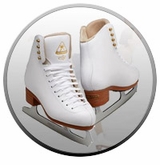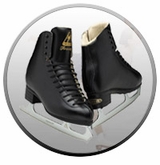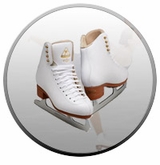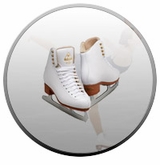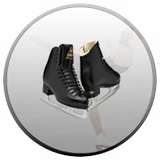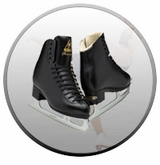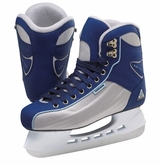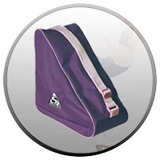How to Ice Skate
Learning how to ice skate can be a rewarding experience, and can provide a lifetime of exercise and recreation. Our goal is to provide you with some information that will help you along as you learn how to ice skate. We will look at how to ice skate forwards and backwards by using the sculling, stroking and crossovers techniques. We will also look at how to perform turns (the three-turn and the Mohawk) while ice skating. But first, we will provide some practical tips that can help you prepare to learn how to ice skate.
As you are learning how to ice skate, you may find your muscles tensing up; this is normal. After you gain a little confidence, try to relax your body and be careful not to lock your knees. As a matter of fact, generally speaking, you should bend your knees and lean slightly forward. This will help as you try to relax your upper body, and will help keep you from falling backwards.
Attitude: As you learn how to ice skate, it is important to start out with a positive, "can do" attitude. Try not to become discouraged if it takes you a few tries before you actually learn how to ice skate. Also, be patient while you are learning, and don’t be embarrassed when your movements are not as graceful as you'd like. Remember, every ice skater had to learn how to ice skate at one time or another. It is a good idea for beginning ice skaters to visit the skating rink during the rink’s slow times. This will make the environment less stressful and allow more space to practice; helping you more quickly to learn how to ice skate. For additional ice skating tips, please see Ice Skating Tips.
How to Ice Skate Forward
Let’s move now to some specific guidance to help you learn how to ice skate. First, you’ll need to learn some techniques for skating in a forward direction. We will discuss three ice skating techniques here; sculling, stroking and crossovers.
Sculling
The sculling technique is an excellent method for beginning ice skaters to use to learn to how to ice skate forwards or backwards. Sculling allows new ice skaters to move across the ice without having to lift either skate.
The first thing you’ll need to do is move away from the barrier. Make sure you move far enough away from the barrier so that if you fall you can’t possibly hit it. Moving away from the barrier will also help you focus on the task at hand without relying on a crutch (the barrier) if you start to fall. The following are some tips that will help you learn how to ice skate forward by performing the sculling maneuver.
1. Stand with the feet roughly six inches apart and the body weight evenly distributed between the two skates. 2. Arms straight out to the side. 3. Stand with good posture, looking ahead, back slightly arched. 4. Bend knees and tighten the ankles. 5. Turn the toes out away from each other. 6. Shift the body weight until the skates begin to separate (legs will straighten). 7. Once the legs are almost straight, turn the toes back in toward each other in a pigeon-toed position. 8. After the skates are near the location where they started, turn the toes back out and repeat this motion continuously without stopping.
Stroking
The stroking technique is an excellent method for ice skaters to learn after learning the sculling technique. Stroking takes ice skaters to a new level by requiring them to skate on one foot at a time. The following are some tips that will help you learn how to ice skate forward while performing the stroking maneuver.
1. Take a position away from the barrier; at least far enough away to make it impossible to hit it in the event of a fall. 2. Begin in a t-position with the right foot forward and the left foot behind at a 45 degree angle; the ice skates should be touching. 3. The shoulders will be slightly toward the left. 4. Left arm will be slightly toward the front, the right slightly toward the back. 5. Bend both knees; the weight should be mostly on the back “left” skate. 6. To begin moving forward, shift the body weight to the right “forward” foot and push off with the left. 7. The body will be forward and the ice skater will be gliding on the right foot. 8. Once the forward motion begins to slow, bring the left foot in next to the right; weight should be distributed evenly on both skates. 9. Bend the knees, and push against the ice with the right foot - the right foot should be at a 45 degree angle when pushing off: (the ice skater will be gliding on the left foot). 10. Repeat steps eight and nine continually without stopping.
Crossovers
The crossover technique requires the ice skater to cross one leg over the other while skating either forwards or backwards. The crossover is similar to the stroking motion with the exception that the legs literally cross over one another. The crossover technique is an essential movement for all ice skaters to learn and perfect. The crossover will be used for going in circles, rounding corners, building speed and performing figure skating jumps, figure skating spins and other figure skating moves. The following are some tips that will help you learn how ice skate forward while performing the stroking maneuver. We will describe the right over left crossover while skating in a circle.
1. Begin ice skating using the normal stroking technique. 2. Bend the skating knee deeply with each stroke. 3. Lean the body toward the center of the circle. 4. Right arm in front and left arm in back. 5. Cross the right leg a comfortable distance across the left leg and transfer the body weight to the right skate; the right skate should now be on an inside edge. 6. Bend the right knee and begin to straighten the left knee. 7. Push with the left skate’s outside edge in a smooth, but thrusting motion. 8. Perform a normal stroking motion then repeat this process.
How to Ice Skate Backwards
Now that you have learned how to ice skate forward by sculling, stroking and performing crossovers, you are now ready to learn how to ice skate backwards. Here we will look at the same the ice skating techniques, backward sculling, backward stroking and backward crossovers.
Backward Sculling
Backward sculling is performed the same as forward sculling, with the one big obvious difference – the direction. The following are some tips that will help you learn how to ice skate backwards using the backwards sculling technique.
1. Stand with the feet around six inches apart and the body weight evenly distributed between the two skates. 2. Arms straight out to the side. 3. Stand with good posture, looking ahead, back slightly arched. 4. Bend knees and tighten ankles. 5. Turn the toes in toward each other in a pigeon-toed position. 6. Shift the body weight until the skates begin to separate (legs will straighten). 7. Once the legs are almost straight, turn the toes back away from each other. 8. After the skates are near the location where they started, turn the toes back in toward each other and repeat this motion continuously without stopping.
Backward Stroking
The backward stroking technique is the next logical method for ice skaters to learn after learning the backward sculling technique. The following are some tips that will help you learn how to ice skate backwards using the backward stroking maneuver.
1. Stand with the feet around six inches apart and the body weight evenly distributed between the two skates. 2. Arms straight out to the side. 3. Stand with good posture, looking back over your shoulder, lean slightly forward. 4. Bend knees and tighten ankles. 5. Turn the left foot in with the toe pointing in the direction of the right foot. 6. Push off with the left foot and shift the body weight to the right foot; you will be gliding backwards on the right foot. 7. Lift the left foot. 8. As you begin to slow down, bring the left foot back along side the right foot and place it on the ice. 9. This time turn the right foot in with the toe pointing in the direction of the left foot, but not as inward as the initial take off (also, remember you are now moving so the push off will feel a little different). 10. Push off with the right foot and shift the body weight to the left foot. 11. As you begin to slow down, bring the right foot back along side the left foot and place it on the ice. 12. Repeat these steps continually.
Backward Crossovers
Backward crossovers provide ice skaters an excellent method for rapidly gaining speed while skating backwards. We recommend that backward crossovers first be learned by skating in a clockwise direction. The following are some tips that will help you learn how to ice skate backwards using the backwards crossover technique.
1. Begin ice skating using the normal backwards stroking technique. 2. Bend the skating knee with each stroke. 3. Lean the body toward the center of the circle, looking over the left shoulder. 4. Left arm and shoulder are back. 5. Cross the right leg a comfortable distance across the left leg and transfer the body weight to the left skate. 6. Push off with the left skate. 7. Cross the left leg a comfortable distance across the right leg and transfer the body weight to the right skate. 8. Push off with the right skate. 8. Repeat these steps.
Ice Skating Turns
As you learn how to ice skate forwards and backwards, you will inevitably need to learn how to switch from forward to backward skating, and vise-versa while skating. Here we are going to look at two ice skating turns; the three turn and the Mohawk.
Three-turn
During the three-turn, the ice skater can turn from either going from backward skating to forward skating, or forward skating to backward skating. If done correctly, the ice skate blades will trace the number three on the ice. The following are some tips that will help you learn how to switch directions by performing the three-turn maneuver
1. Begin skating forward on a left outside edge, and place your right foot just off the ice, and pointed toward the right. 2. Look in the direction you are skating, the left arm should be in the front and the right arm out to the side. 3. Bend both knees, keep right leg off the ice, but bring it in near the left leg. 4. Perform an outside edge with your left foot, pushing off with the right inside edge. 5. Straighten the left knee and transfer the weight to the ball of the foot. 6. Twist the upper body counterclockwise, shift the left skate, and spin it around in the opposite direction you were skating. 7. You are now skating backwards with the left arm to the back (direction skating) and the right arm to the front of the body.
Mohawk
The Mohawk is performed much like the three-turn, but on two feet. There are various options to performing the Mohawk turn, but we will look at one of the simplest - an inside Mohawk. The following are some tips that will help you learn how to perform the inside Mohawk turn.
1. Begin skating forward on a right inside edge. 2. Right arm should be extended to the front, left arm toward the back. 3. Bring the left foot in next to the right foot. 4. Rotate the body counterclockwise, and shift the weight to the back of the right blade. 5. When the rotation is complete, place the left skate down (pointed out away from the right foot) and perform a back inside edge. 6. You are now skating backwards with the right leg extended to the rear. 7. Right arm should now be in the back (direction skating) and the left arm to the front of the body.
|
Skate Equipment >
Ice Skating Equip
Ice Skating Info
.
